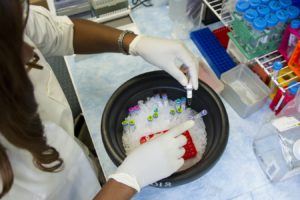
BMC Cancer – Are cancer patients better off if they participate in clinical trials? A mixed-methods study
 Trial participation has not been found to provide better outcomes for cancer patients than standard care. With nearly one in six deaths estimated to be due to cancer, interest in innovative cancer research and treatment breakthroughs is high. A previous study showed that the information given to cancer trial participants and their physicians can be misleading, with information heavily focused on positive outcomes, with little information on the possible adverse effects or disadvantages of taking part. This can blur the boundaries between treatment and research, resulting in the belief that the best treatment for cancer provided within the context of a clinical trial. Through interviews and a systematic review of the literature, Nielsen et al. explored how physicians and nurses perceived the benefits of clinical trial participation and whether clinical trial participation provided better outcomes for cancer patients. Interviews revealed that there is a widespread belief amongst nurses and physicians that treatment for cancer, in the context of a clinical trial, is better than standard care. Many believed that recruiting patients to trials is a way to give them access to cutting-edge treatment. A search of the literature found no support for the belief that treatment in clinical trials is superior to standard care, despite rapid developments in cancer treatment in recent years. Lack of trial reporting transparency was also said to contribute to the belief that participating in trials is associated with better outcomes. Patient information sheets for cancer clinical trials should be designed to be free of suggestions that trial participation is the best treatment option for cancer patients. The focus should be shifted to encourage trial participation to further knowledge, to the potential benefit of future patients.
Trial participation has not been found to provide better outcomes for cancer patients than standard care. With nearly one in six deaths estimated to be due to cancer, interest in innovative cancer research and treatment breakthroughs is high. A previous study showed that the information given to cancer trial participants and their physicians can be misleading, with information heavily focused on positive outcomes, with little information on the possible adverse effects or disadvantages of taking part. This can blur the boundaries between treatment and research, resulting in the belief that the best treatment for cancer provided within the context of a clinical trial. Through interviews and a systematic review of the literature, Nielsen et al. explored how physicians and nurses perceived the benefits of clinical trial participation and whether clinical trial participation provided better outcomes for cancer patients. Interviews revealed that there is a widespread belief amongst nurses and physicians that treatment for cancer, in the context of a clinical trial, is better than standard care. Many believed that recruiting patients to trials is a way to give them access to cutting-edge treatment. A search of the literature found no support for the belief that treatment in clinical trials is superior to standard care, despite rapid developments in cancer treatment in recent years. Lack of trial reporting transparency was also said to contribute to the belief that participating in trials is associated with better outcomes. Patient information sheets for cancer clinical trials should be designed to be free of suggestions that trial participation is the best treatment option for cancer patients. The focus should be shifted to encourage trial participation to further knowledge, to the potential benefit of future patients.
BMC Energy – Comparing negative emissions and high renewable scenarios for the European power system

High renewable power system scenarios coupled with low levels of negative emissions technologies, such as carbon capture and storage, could deliver a net-negative European power system by 2050. Decarbonizing electricity generation is key to achieving the Paris Climate Agreement for limiting average global temperature rise to ‘well below 2°C’ above pre-industrial levels. Gaffney et al. modeled emissions reduction, technical operation, and system costs for the year 2050. The analysis was designed to also include short time windows, to gain insights into the impact of high levels of variable renewable energy sources. It was demonstrated that high renewable power systems, coupled with negative emissions technologies, such as biomass carbon capture and storage, can deliver a net-negative European power system at lower costs, without breaching published sustainable biomass and geological storage potentials in Europe, with the opportunity to contribute to power system inertia. This study offers a first step in the comparison of future decarbonization scenarios and highlights concerns with system operation, economics, and emissions reduction, at a European scale.
 Nurses, using computerized decision support systems, performed better on a large number of health-related items than GPs, in telephone triage. Out-of-hours primary care services are increasing in a number of regions around the globe. Telephone triage is instrumental in the management of patient flow and workload. However, ensuring triage services are safe and efficient remains a challenge. Some countries, such as Denmark, use GPs to primarily perform triage services. However, this is hotly debated since many countries report increasing shortages of GPs, and GPs have self-reported high stress and burn-out symptoms. Graverson et al. studied a random sample of audio-recorded telephone triage calls from Danish out-of-hours primary care services triaged by GPs, nurses using computerized decision support systems, or physicians with different medical specialties. Nurses using computerized decision support systems performed better than GPs in telephone triage on a large number of health-related items, had lower levels of undertriage but were perceived less efficient. Nurse-led triage offers a solution for high GP workload seems feasible, but further research is needed since fewer GPs may be required for telephone triage services, but more GPs may be needed to meet out-of-hours service demand.
Nurses, using computerized decision support systems, performed better on a large number of health-related items than GPs, in telephone triage. Out-of-hours primary care services are increasing in a number of regions around the globe. Telephone triage is instrumental in the management of patient flow and workload. However, ensuring triage services are safe and efficient remains a challenge. Some countries, such as Denmark, use GPs to primarily perform triage services. However, this is hotly debated since many countries report increasing shortages of GPs, and GPs have self-reported high stress and burn-out symptoms. Graverson et al. studied a random sample of audio-recorded telephone triage calls from Danish out-of-hours primary care services triaged by GPs, nurses using computerized decision support systems, or physicians with different medical specialties. Nurses using computerized decision support systems performed better than GPs in telephone triage on a large number of health-related items, had lower levels of undertriage but were perceived less efficient. Nurse-led triage offers a solution for high GP workload seems feasible, but further research is needed since fewer GPs may be required for telephone triage services, but more GPs may be needed to meet out-of-hours service demand.
BMC Research Notes – Multiplex PCR for identification of two butterfly sister species: Eurema mandarina and Eurema hecabe
 A multiplex PCR method has been found to accurately and reliably distinguish between closely related species of butterflies. In insects, closely related species are often difficult or impossible to distinguish solely by morphological traits alone. Existing techniques, such as using mitochondrial DNA markers, are not always available for species with complex genomic histories. Miyata et al. developed a multiplex PCR method to amplify and distinguish the sequences of the triose phosphate isomerase (Tpi) gene of two species of Japanese grass yellow butterflies (Eurema mandarina and Eurema hecabe). The method designed was found to easily, reliably, and cost-effectively distinguish between two species of butterfly. The Tpi gene sequences were found to be sufficiently variable to differentiate different species but invariable enough to allow designing primers within species. The Tpi gene offers a potential target for marker development of multiplex PCR to distinguish other closely related butterfly species when other approaches are unavailable.
A multiplex PCR method has been found to accurately and reliably distinguish between closely related species of butterflies. In insects, closely related species are often difficult or impossible to distinguish solely by morphological traits alone. Existing techniques, such as using mitochondrial DNA markers, are not always available for species with complex genomic histories. Miyata et al. developed a multiplex PCR method to amplify and distinguish the sequences of the triose phosphate isomerase (Tpi) gene of two species of Japanese grass yellow butterflies (Eurema mandarina and Eurema hecabe). The method designed was found to easily, reliably, and cost-effectively distinguish between two species of butterfly. The Tpi gene sequences were found to be sufficiently variable to differentiate different species but invariable enough to allow designing primers within species. The Tpi gene offers a potential target for marker development of multiplex PCR to distinguish other closely related butterfly species when other approaches are unavailable.
BMC Veterinary Research – Pharmacokinetics and analgesic effects of intravenous, intramuscular or subcutaneous buprenorphine in dogs undergoing ovariohysterectomy: a randomized, prospective, masked, clinical trial
 Route of administration has been found to influence the analgesic efficiency of buprenorphine in dogs. Buprenorphine is used for postoperative pain management in cats and dogs, for example, in routine spays, known clinically as ovariohysterectomies. Previous studies have described the pharmacokinetics of the drug, however, the pharmacodynamics effect of this drug has not been consistently reported in these studies, which is important for understanding the absorption, distribution, metabolism, and elimination of the drug in companion animals. Steagall et al. randomized dogs in a masked clinical trial to either receive buprenorphine intravenously, intramuscularly or subcutaneously before ovariohysterectomy and pain was scored with the Glasgow composite pain scale for dogs. Pharmacokinetic analysis was carried out on the dog’s blood samples. Subcutaneous administration of buprenorphine failed to provide sufficient analgesia due to erratic drug absorption. Dogs in this group received the highest amount of rescue pain relief compared to dogs that received buprenorphine intravenously or intramuscularly. At the doses administered, intravenous and intramuscular routes of administration are preferred for postoperative buprenorphine analgesia.
Route of administration has been found to influence the analgesic efficiency of buprenorphine in dogs. Buprenorphine is used for postoperative pain management in cats and dogs, for example, in routine spays, known clinically as ovariohysterectomies. Previous studies have described the pharmacokinetics of the drug, however, the pharmacodynamics effect of this drug has not been consistently reported in these studies, which is important for understanding the absorption, distribution, metabolism, and elimination of the drug in companion animals. Steagall et al. randomized dogs in a masked clinical trial to either receive buprenorphine intravenously, intramuscularly or subcutaneously before ovariohysterectomy and pain was scored with the Glasgow composite pain scale for dogs. Pharmacokinetic analysis was carried out on the dog’s blood samples. Subcutaneous administration of buprenorphine failed to provide sufficient analgesia due to erratic drug absorption. Dogs in this group received the highest amount of rescue pain relief compared to dogs that received buprenorphine intravenously or intramuscularly. At the doses administered, intravenous and intramuscular routes of administration are preferred for postoperative buprenorphine analgesia.
Comments